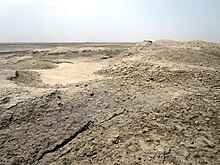Tell al-'Ubaid
العبيد | |
 | |
| Location | Dhi Qar Governorate, Iraq |
|---|---|
| Region | Lower Mesopotamia |
| Coordinates | 30°58′12″N 46°1′32″E / 30.97000°N 46.02556°E |
| Type | tell, type site |
| Length | 350 metre |
| Width | 250 metre |
| Height | 2 metre |
| History | |
| Periods | Early Dynastic period, Ubaid period, Jemdet Nasr period, Ur III period |
| Site notes | |
| Excavation dates | 1919; 1923; 1924; 1937 |
| Archaeologists | Henry Hall, Leonard Woolley, Pinhas Pierre Delougaz, Seton Lloyd |
Tell al-'Ubaid (
History of archaeological research
The site was first worked by
Tell al-'Ubaid and its environment
Today, Tell al-'Ubaid lies 250 kilometres (160 mi) from the Persian Gulf, but the shoreline lay much closer to the site during the Ubaid period. The tell, or settlement mound, is an oblong measuring approximately 500 by 300 metres (1,640 ft × 980 ft) on a roughly north-south axis. It extends about 2 metres (6 ft 7 in) above the current surface. The excavated Early Dynastic temple of Ninḫursaĝ, A-Ane-pada, is located on the northern edge of the site. Finds included a copper framed frieze of limestone birds set in a black shale background.[7] The temple was also worked on in the Ur III period.[8][9] A cemetery was also found with 96 graves, mostly from the Early Dynastic Period.[10]
Occupation history
The lower level of the site featured large amounts of Ubaid pottery and associated
Gallery
-
Stone statue of Kurlil, Early Dynastic III, 2500 BC Tell Al-'Ubaid
-
Parts of mosaic columns from the entrance to the Temple of Ninhursag at Tell al-'Ubaid, Iraq, 2800-2600 BCE. Iraq Museum
-
Recumbent cow, part of a frieze once decorated the facade of the Temple of Ninhursag at Tell al-'Ubaid, Iraq, 2800-2600 BCE. Iraq Museum
-
Sumerian scene, milking cows and making dairy products. From the facade of the Temple of Ninhursag at Tell al-'Ubaid, Iraq, 2800-2600 BCE. Iraq Museum
See also
- Cities of the Ancient Near East
- Copper Bull
- Tell al-'Ubaid Copper Lintel
References
- ^ Frayne, Douglas R. and Stuckey, Johanna H.. "N". A Handbook of Gods and Goddesses of the Ancient Near East: Three Thousand Deities of Anatolia, Syria, Israel, Sumer, Babylonia, Assyria, and Elam, University Park, USA: Penn State University Press, 2021, pp. 219-287
- ^ H. R. Hall, Season's Work at Ur; Al-'Ubaid, Abu Shahrain (Eridu), and Elsewhere; Being an Unofficial Account of the British Museum Archaeological Mission to Babylonia, 1919, Methuen, 1930
- ^ Reade, Julian. "Early monuments in Gulf stone at the British Museum, with observations on some Gudea statues and the location of Agade" , vol. 92, no. 2, 2002, pp. 258-295
- ^ Hall, H. R.; Woolley, C. L. (1927). UR Excavations Volume I Al-'Ubaid. Oxford University Press.
- S2CID 130499268.
- ^ Seton Lloyd, Ur-al 'Ubaid, 'Uqair and Eridu. An Interpretation of Some Evidence from the Flood-Pit, Iraq, ol. 22, Ur in Retrospect. In Memory of Sir C. Leonard Woolley, pp. 23-31, (Spring - Autumn, 1960)
- ^ [1]Paszke, Marcin Z., "Bird species diversity in 3rd millennium BC Mesopotamia: The case of the Al-Ubaid bird frieze from the Temple of Nin", Bioarchaeology of the Near East 15, pp. 25-54, 2021
- ^ JSTOR 4200519.
- ^ Clayden, Tim. “KASSITE HOUSING AT UR: THE DATES OF THE EM, YC, XNCF, AH AND KPS HOUSES.” Iraq, vol. 76, 2014, pp. 19–64
- ^ Harriet P. Martin, The Early Dynastic Cemetery at al-'Ubaid, a Re-Evaluation, Iraq, vol. 44, no. 2, pp. 145-185, 1982






